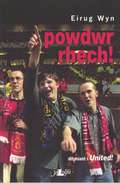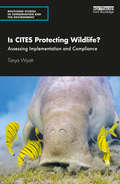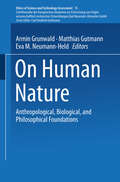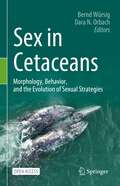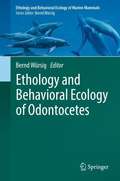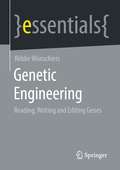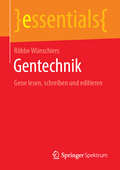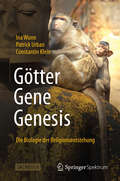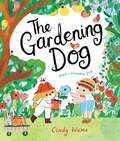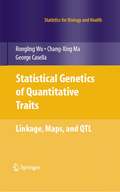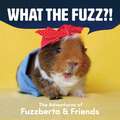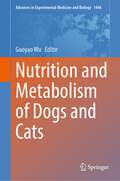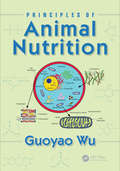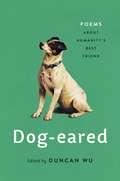- Table View
- List View
Veterinary Herbal Medicine E-Book
by Susan G. Wynn Barbara FougereThis full-color reference offers practical, evidence-based guidance on using more than 120 medicinal plants, including how to formulate herbal remedies to treat common disease conditions. A body-systems based review explores herbal medicine in context, offering information on toxicology, drug interactions, quality control, and other key topics.More than 120 herbal monographs provide quick access to information on the historical use of the herb in humans and animals, supporting studies, and dosing information. Includes special dosing, pharmacokinetics, and regulatory considerations when using herbs for horses and farm animals. Expanded pharmacology and toxicology chapters provide thorough information on the chemical basis of herbal medicine. Explores the evolutionary relationship between plants and mammals, which is the basis for understanding the unique physiologic effects of herbs. Includes a body systems review of herbal remedies for common disease conditions in both large and small animals. Discusses special considerations for the scientific research of herbs, including complex and individualized interventions that may require special design and nontraditional outcome goals.
Powdwr Rhech!
by Eirug WynNofel fywiog am helyntion criw o gefnogwyr tîm pêl-droed Manchester United wrth iddynt geisio mynychu gêm bêl-droed yn Old Trafford er iddynt gael eu gwahardd rhag gwneud hynny. Dilyniant i United!; i ddarllenwyr 12-15 oed. [A lively novel about the escapades of a crew of Manchester United football supporters as they try to go to a football game at Old Trafford although they have been banned from doing so. A sequel to United!; for 12-15 year-old readers.] *Datganiad hawlfraint Gwneir y copi hwn dan dermau Rheoliadau (Anabledd) Hawlfraint a Hawliau mewn Perfformiadau 2014 i'w ddefnyddio gan berson sy'n anabl o ran print yn unig. Oni chaniateir gan gyfraith, ni ellir ei gopïo ymhellach, na'i roi i unrhyw berson arall, heb ganiatâd.
Understories: Plants and Culture in the American Tropics (American Tropics: Towards a Literary Geography #9)
by Lesley WylieUnderstories: Plants and Culture in the American Tropics establishes the central importance of plants to the histories and cultures of the extended tropical region stretching from the U.S. South to Argentina. Through close examination of a number of significant plants – cacao, mate, agave, the hevea brasilensis, kudzu, the breadfruit, soy, and the ceiba pentandra, among others – this volume shows that vegetal life has played a fundamental role in shaping societies and in formulating cultural and environmental imaginaries in and beyond the region. Drawing on a wide range of cultural traditions and forms across literature, popular music, art, and film, the essays included in this volume transcend regional and linguistic boundaries to bring together multiple plant-centred histories or ‘understories’ – narratives that until now have been marginalized or gone unnoticed. Attending not only to the significant influence of humans on plants, but also of plants on humans, this book offers new understandings of how colonization, globalization, and power were, and continue to be, imbricated with nature in the American tropics.
Is CITES Protecting Wildlife?: Assessing Implementation and Compliance (Routledge Studies in Conservation and the Environment)
by Tanya WyattThis book assesses the Convention on International Trade in Endangered Species of Wild Fauna and Flora (CITES), examining both implementation and compliance. Humans are causing a biodiversity crisis, where 1 million species are facing extinction. Species are dying, in no small part, because they are overexploited, poached and trafficked and CITES is the main international instrument designed to protect traded wildlife. Does the state of the world’s species mean CITES is failing? This book explores the implementation of and compliance with CITES by all 183 member countries. It is imperative we know the nature and extent of the implementation of and compliance with CITES legislation in all parties to fully understand the impact of legal and illegal trade on species survival. Through extensive legislative content analysis, a Delphi iterative survey, and semi-structured interviews, this is the first book to share empirical research about CITES implementation and compliance. This book contains a comprehensive analysis of the state of CITES, what is done well, what could be done better, and what the future might bring to try to curtail the slide of the world’s wildlife into extinction. By identifying lessons learned in relation to CITES legislation, implementation and compliance this book provides hard evidence to member countries as to how their own practice can be improved. This timely book will be essential reading for students and academics interested in wildlife law, trade and trafficking, green criminology and biodiversity conservation more broadly. It will also be of interest to professionals working in wildlife law enforcement.
Is CITES Protecting Wildlife?: Assessing Implementation and Compliance (Routledge Studies in Conservation and the Environment)
by Tanya WyattThis book assesses the Convention on International Trade in Endangered Species of Wild Fauna and Flora (CITES), examining both implementation and compliance. Humans are causing a biodiversity crisis, where 1 million species are facing extinction. Species are dying, in no small part, because they are overexploited, poached and trafficked and CITES is the main international instrument designed to protect traded wildlife. Does the state of the world’s species mean CITES is failing? This book explores the implementation of and compliance with CITES by all 183 member countries. It is imperative we know the nature and extent of the implementation of and compliance with CITES legislation in all parties to fully understand the impact of legal and illegal trade on species survival. Through extensive legislative content analysis, a Delphi iterative survey, and semi-structured interviews, this is the first book to share empirical research about CITES implementation and compliance. This book contains a comprehensive analysis of the state of CITES, what is done well, what could be done better, and what the future might bring to try to curtail the slide of the world’s wildlife into extinction. By identifying lessons learned in relation to CITES legislation, implementation and compliance this book provides hard evidence to member countries as to how their own practice can be improved. This timely book will be essential reading for students and academics interested in wildlife law, trade and trafficking, green criminology and biodiversity conservation more broadly. It will also be of interest to professionals working in wildlife law enforcement.
On Human Nature: Anthropological, Biological, and Philosophical Foundations (Ethics of Science and Technology Assessment #15)
by F. WütscherModern molecular technology in the so-called life sciences (biology as weil as medicine) allows today to approach and manipulate living beings in ways and to an extent wh ich not too long aga seemed Utopian. The empirical progress promises further and even more radical developments in the future, and it is at least often claimed that this kind of research will have tremendeous etfects on and for all of humanity, for example in the areas of food production, transplantation medicine (including stem cell research and xenotransplantation), (therapeutic) genetic manipulation and (cell-line) cloning (of cell lines or tissues), and of biodiversity conservation-strategies. At least in Western, industrialized countries the development of modern sciences led to a steady increase of human health, well-being and quality of life. However, with the move to make the human body itself an object of scientific research interests, the respective scientific descriptions resulted in changes in the image that human beings have of themselves. Scientific progress has led to a startling loss of traditional human self-understanding. This development is in contrast to an under standing according to which the question what it means to be "human" is treated in the realm of philosophy. And indeed, a closer look reveals that - without denying the value of scientitic progress - science cannot replace the philosophical approach to anthropological questions.
Sex in Cetaceans: Morphology, Behavior, and the Evolution of Sexual Strategies
by Bernd Würsig Dara N. OrbachSex in Cetaceans provides an up-to-date review of multi-faceted aspects related to mating and reproduction in toothed and baleen whales. This open access book begins with discussions of sexual selection and anatomical traits related to mating and diversity between the sexes. The functions of non-conceptive copulations are reviewed as are different research techniques applied to explore sex in cetaceans. Authors and editors build knowledge of female and male social, mating, and parental strategies and tactics for several specific toothed dolphin/porpoise/whale species and baleen whale species. It concludes with a discussion of potential conservation efforts and ways to help especially beleaguered species and populations the world over. The volume is intended as a major primer of cetacean sex for undergraduate and graduate students, new and established researchers in the field, and the public wishing to learn more.
Ethology and Behavioral Ecology of Odontocetes (Ethology and Behavioral Ecology of Marine Mammals)
by Bernd WürsigThis book concentrates on the marine mammalian group of Odontocetes, the toothed whales, dolphins, and porpoises. In 23 chapters, a total of 40 authors describe general patterns of ethological concepts of odontocetes in their natural environments, with a strong bent towards behavioral ecology. Examples are given of particularly well-studied species and species groups for which enough data exist, especially from the past 15 years. The aim is to give a modern flavor of present knowledge of ethology and behavior of generally large-brained behaviorally flexible mammals that have evolved quite separately from social mammals on land. As well, the plight of populations and species due to humans is described in multiple chapters, with the goal that an understanding of behavior can help to solve or alleviate at least some human-made problems.
Rotifera VIII: Proceedings of the VIIIth International Rotifer Symposium, held in Collegeville, Minn., U.S.A., 22–27 June 1997 (Developments in Hydrobiology #134)
by E. Wurdak R. Wallace Hendrik SegersRotifera VIII: A Comparative Approach is a record of the proceedings of the VIIIth International Rotifer Symposium which was held in Collegeville, Minnesota, USA, on June 22-27, 1997. It contains review papers and reports of recent research findings along with the presentation of new methods in rotifer biology. The publications contained in this volume reflect the wide diversity of approaches, methods of analysis and conclusions that characterize research on the Rotifera. Some of the topics addressed are: rotifer distribution, responses to biotic and abiotic factors, genetic profile of individuals and populations, rotifer feeding and mating behavior, morphology, phylogeny and taxonomy. These studies will be of great interest to invertebrate zoologists and limnologists, particularly those interested in freshwater habitats.
Genetic Engineering: Reading, Writing and Editing Genes (essentials)
by Röbbe WünschiersThis essential should serve as an introduction for a contemporary public discussion on genetic engineering. Genetic engineering affects us all in many areas and we must dare to think more colorful and further. In fact, the complete genetic material of viruses and bacteria can already be chemically produced and "brought to life". With genetic surgery, medicine is at a crossroads: do we want to treat hereditary diseases or "repair" them genetically? And the analysis of thousands of human genetic material reveals information that is related to complex diseases, but also to characteristics such as intelligence. How should we use this knowledge? The question is hardly whether we want genetic engineering, but rather how we use it.This Springer essential is a translation of the original German 1st edition essentials, Gentechnik by Röbbe Wünschiers, published by The Editor(s) (if applicable) and The Author(s), under exclusive license to Springer Fachmedien Wiesbaden GmbH, part of Springer Nature in 2019. The translation was done with the help of artificial intelligence (machine translation by the service DeepL.com). A subsequent human revision was done primarily in terms of content, so that the book will read stylistically differently from a conventional translation. Springer Nature works continuously to further the development of tools for the production of books and on the related technologies to support the authors.
Gentechnik: Gene lesen, schreiben und editieren (essentials)
by Röbbe WünschiersDieses essential soll als Einführung für eine zeitgemäße öffentliche Diskussion zur Gentechnologie dienen. Die Gentechnik betrifft uns alle in vielen Bereichen und wir müssen uns trauen, bunter und weiter zu denken. Tatsächlich kann bereits das komplette Erbgut von Viren und Bakterien chemisch erzeugt und „zum Leben erweckt“ werden. Mit der Genchirurgie ist die Medizin an einem Scheidepunkt: Wollen wir Erbkrankheiten therapieren oder genetisch „reparieren“? Und die Analyse tausender menschlicher Erbgute fördert Informationen zutage, die mit komplexen Krankheiten, aber auch Merkmalen wie Intelligenz in Verbindung stehen. Wie sollen wir dieses Wissen nutzen? Es stellt sich kaum noch die Frage, ob wir Gentechnik wollen, sondern vielmehr, wie wir sie anwenden.
Götter - Gene - Genesis: Die Biologie der Religionsentstehung
by Ina Wunn Patrick Urban Constantin KleinIst Gott in den Genen zu finden? Ist Religion göttlichen Ursprungs – oder doch ein natürliches, also biologisches Phänomen? Und wenn Religion in unserer Biologie angelegt ist, wie und warum ist sie entstanden? Wie sehen ihre Anfänge aus, die ja sehr einfach gewesen sein müssen – Religion im Einzellerstadium sozusagen! Wie entwickelte sie sich dann weiter, und lassen sich in dieser Entwicklung, wie bei der biologischen Evolution, Gesetzmäßigkeiten feststellen? Anders ausgedrückt: Gibt es eine Biologie der Religionen beziehungsweise eine Biologie der Religionsentstehung? Dieses Buch unternimmt erstmalig den Versuch einer umfassenden Antwort auf diese Fragen. Die Autoren – Experten aus Biologie, Paläontologie, Psychologie, Religionswissenschaft und Theologie – entwerfen auf der Basis fächerübergreifender wissenschaftlicher Befunde ein Modell der Religionsentstehung, das das Aufkommen religiöser Verhaltensweisen schlüssig aus dem natürlichen Verhaltensrepertoire des Menschen erklärt. So wird die menschheitsgeschichtliche Entwicklung von Religiosität plausibel und nachvollziehbar. Wer wissen will, wie Religion entstanden ist, wird in diesem breiten und sachkundigen Überblick die Antwort finden. _____ Die Götter fielen nicht vom Himmel – die biologischen Grundlagen der Religionsentstehung Religion ist ein universal verbreitetes Phänomen, und überall auf der Welt prägen religiöse Überzeugungen politisches und gesellschaftliches Handeln. Viele Menschen wollen verstehen, warum Religion trotz aller rationalen Kritik fortbesteht, und fragen deshalb auch nach ihren Anfängen und ihrer Entwicklung in der Menschheitsgeschichte. Götter – Gene – Genesis ist der ehrgeizige Versuch dreier interdisziplinär arbeitender Autoren, den Ursprung von Religion schlüssig und nachvollziehbar zu erklären. Ihr Buch verfolgt insofern einen originellen Ansatz, als es den aktuellen kognitionswissenschaftlichen und evolutionär-psychologischen Entwürfen zur Erklärung der Religionsentstehung eine ganz bewusst verhaltensorientierte Perspektive entgegensetzt: Religiöses Verhalten wird konsequent verhaltenswissenschaftlich – ethologisch, biologisch, psychologisch – erklärt. Entscheidende Faktoren für die frühe Entwicklung von Religiosität sind Territorialverhalten und Gefahrenabwehr, innerartliche Aggression und Ritualisierung, Angstbewältigung und Konfliktlösung sowie die kulturelle Evolution als Fortsetzung der biologischen Evolution. Mit der konsequenten Herausarbeitung der biologischen Grundlagen bietet das Buch einen Überblick zur Religionsentstehung, der sehr viel „bodenständiger“ und oft auch im Wortsinne „anschaulicher“ ist als manch andere, spekulative Entstehungsszenarien. Die Lektüre des Buches vermittelt dem Leser fundierte Kenntnisse über die Erscheinungsformen und Geschichte religiösen Verhaltens – und liefert so einen wichtigen Beitrag für die heute oft so emotional geführte Debatte zu Glaubensfragen.
Ancestors, Territoriality, and Gods: A Natural History of Religion (The Frontiers Collection)
by Ina Wunn Davina GrojnowskiThis books sets out to explain how and why religion came into being. Today this question is as fascinating as ever, especially since religion has moved to the centre of socio-political relationships. In contrast to the current, but incomplete approaches from disciplines such as cognitive science and psychology, the present authors adopt a new approach, equally manifest and constructive, that explains the origins of religion based strictly on behavioural biology. They employ accepted research results that remove all need for speculation. Decisive factors for the earliest demonstrations of religion are thus territorial behaviour and ranking, coping with existential fears, and conflict solution with the help of rituals. These in turn, in a process of cultural evolution, are shown to be the roots of the historical and contemporary religions.
The Bookshop Cat
by Cindy WumeA joyous and dazzlingly original picture book about a beloved bookshop cat, the power of reading and the importance of family and community, from the talented Cindy Wume.The Bookshop Cat loves his job at the Children's Bookshop, where he spends his time reading, purring and recommending his favourite books to all the children that come into the shop. But one day, disaster strikes! The bookshop is flooded, and the children stop coming to visit. With a bit of help from his family and friends, the Bookshop Cat comes up with a brilliant plan to bring the Children's Bookshop back to life!
The Gardening Dog
by Cindy WumeMeet two very special friends in this heartwarming and beautifully illustrated tale. Watch as a boy and a dog who don't quite fit in learn that a friendship, like a garden, takes time to grow - but that both are always worth the wait.The Gardening Dog is never chosen to go home with anyone who visits the rescue centre where she lives. Instead she spends her time quietly growing beautiful plants. Then one day she meets a boy called Lewis, who much prefers drawing to running around with all the other children. Working together, Lewis and The Gardening Dog create a wonderful community garden for everyone to share – and as new shoots grow outside, they build a deep friendship that leads to a new start for them both.
Clinical Small Animal Care: Promoting Patient Health through Preventative Nursing
by Kimm WuestenbergClinical Small Animal Care: Promoting Patient Health through Preventative Nursing is an introduction to the principles of day-to-day veterinary practice, with coverage ranging from the initial assessment, fluid therapy monitoring, and perioperative management to care of animals with specific diseases. The book offers concrete guidance on best practices for promoting patient health in veterinary care, emphasizing specific techniques to prevent complications before they happen. A practical, clinically relevant resource for veterinary technicians, Clinical Small Animal Care provides step-by-step descriptions of the core tasks associated with examining, nursing, and monitoring small animal patients. Taking a hands-on approach to the fundamentals of clinical practice, the book gives specific advice for how to perform tasks associated with patient care. Chapters begin with basic information on topics such as husbandry and nutrition, then move into more specialized information on applied nursing and the care of tubes and catheters. The final section presents information on caring for animals with a variety of conditions organized by body system. Clinical Small Animal Care: Promoting Patient Health through Preventative Nursing offers veterinary technicians and nurses with achievable steps for improving health in their small animal patients.
Clinical Small Animal Care: Promoting Patient Health through Preventative Nursing
by Kimm WuestenbergClinical Small Animal Care: Promoting Patient Health through Preventative Nursing is an introduction to the principles of day-to-day veterinary practice, with coverage ranging from the initial assessment, fluid therapy monitoring, and perioperative management to care of animals with specific diseases. The book offers concrete guidance on best practices for promoting patient health in veterinary care, emphasizing specific techniques to prevent complications before they happen. A practical, clinically relevant resource for veterinary technicians, Clinical Small Animal Care provides step-by-step descriptions of the core tasks associated with examining, nursing, and monitoring small animal patients. Taking a hands-on approach to the fundamentals of clinical practice, the book gives specific advice for how to perform tasks associated with patient care. Chapters begin with basic information on topics such as husbandry and nutrition, then move into more specialized information on applied nursing and the care of tubes and catheters. The final section presents information on caring for animals with a variety of conditions organized by body system. Clinical Small Animal Care: Promoting Patient Health through Preventative Nursing offers veterinary technicians and nurses with achievable steps for improving health in their small animal patients.
Schistosomiasis Control in China: The successful example of Jiangxi province (Parasitology Research Monographs #11)
by Zhongdao Wu Yiwen Liu Heinz MehlhornThis book covers all details for a successful control and elimination strategy against propagation of deadly liver and intestinal flukes of the genus Schistosoma in China. Cancer due to schistosomiasis is still common in subtropical countries and affords hundred thousands of human and animal deaths per year. Expert authors play close attention to the biology and morphologic aspects of Schistosoma species as well as the history and status quo of schistosomiasis epidemiology. In a unique way, the present work illustrates the need to involve strategic measurements, and to control both adult worms and larval parasite stages. With a special focus on Jiangxi Province, the authors present an effective management plan, ranging from intermediate host snail control to diagnostic tools, medical aid, as well as public health education. This approach from China can be used as blueprint in other countries hit by the same worm infections. The contents of this book will thus be meaningful for academics and practitioners in the fields of parasitology, public health, as well as human and veterinary medicine.
Statistical Genetics of Quantitative Traits: Linkage, Maps and QTL (Statistics for Biology and Health)
by Rongling Wu Changxing Ma George CasellaThis book introduces the basic concepts and methods that are useful in the statistical analysis and modeling of the DNA-based marker and phenotypic data that arise in agriculture, forestry, experimental biology, and other fields. It concentrates on the linkage analysis of markers, map construction and quantitative trait locus (QTL) mapping, and assumes a background in regression analysis and maximum likelihood approaches. The strength of this book lies in the construction of general models and algorithms for linkage analysis, as well as in QTL mapping in any kind of crossed pedigrees initiated with inbred lines of crops.
What the Fuzz?!: The Adventures of Fuzzberta and Friends
by Monica WuFluffballs Fuzzberta and Friends have been taking the internet by storm as they chronicle their lives via fancy dress, from highlighting the best of film and fashion to offering behind-the-scenes material of what they get up to in their spare time. Now this guinea-pig gang has collected its all-time favourite and exclusive photos in one book for all non-fuzzy beings to enjoy!
Nutrition and Metabolism of Dogs and Cats (Advances in Experimental Medicine and Biology #1446)
by Guoyao WuThis book provides new knowledge about the nutrition and metabolism, as well as the roles of nutrients in the immunity, health, and management of companion animals (dogs and cats). The domestic dog (facultative carnivore) and the domestic cat (obligate carnivore) have evolved differentially in their digestive tract, nutrition, metabolism, chemical sensing, and feeding behavior. These animals have been human companions for at least 12,000 and 9,000 years, respectively, and continue to contribute to the mental health and well-being of children, adolescents, and adults. Both dogs and cats have become increasingly popular in many countries and worldwide over the past decades. Comprehensive update about how the animals utilize dietary nutrients for optimum growth, development, and health is beneficial for their owners, as well as students and researchers. Chapter 4: Characteristics of Nutrition and Metabolism in Dogs and Cats is available open access under a Creative Commons Attribution 4.0 International License
Principles of Animal Nutrition
by Guoyao WuAnimals are biological transformers of dietary matter and energy to produce high-quality foods and wools for human consumption and use. Mammals, birds, fish, and shrimp require nutrients to survive, grow, develop, and reproduce. As an interesting, dynamic, and challenging discipline in biological sciences, animal nutrition spans an immense range from chemistry, biochemistry, anatomy and physiology to reproduction, immunology, pathology, and cell biology. Thus, nutrition is a foundational subject in livestock, poultry and fish production, as well as the rearing and health of companion animals. This book entitled Principles of Animal Nutrition consists of 13 chapters. Recent advances in biochemistry, physiology and anatomy provide the foundation to understand how nutrients are utilized by ruminants and non-ruminants. The text begins with an overview of the physiological and biochemical bases of animal nutrition, followed by a detailed description of chemical properties of carbohydrates, lipids, protein, and amino acids. It advances to the coverage of the digestion, absorption, transport, and metabolism of macronutrients, energy, vitamins, and minerals in animals. To integrate the basic knowledge of nutrition with practical animal feeding, the book continues with discussion on nutritional requirements of animals for maintenance and production, as well as the regulation of food intake by animals. Finally, the book closes with feed additives, including those used to enhance animal growth and survival, improve feed efficiency for protein production, and replace feed antibiotics. While the classical and modern concepts of animal nutrition are emphasized throughout the book, every effort has been made to include the most recent progress in this ever-expanding field, so that readers in various biological disciplines can integrate biochemistry and physiology with nutrition, health, and disease in mammals, birds, and other animal species (e.g., fish and shrimp). All chapters clearly provide the essential literature related to the principles of animal nutrition, which should be useful for academic researchers, practitioners, beginners, and government policy makers. This book is an excellent reference for professionals and a comprehensive textbook for senior undergraduate and graduate students in animal science, biochemistry, biomedicine, biology, food science, nutrition, veterinary medicine, and related fields.
Principles of Animal Nutrition
by Guoyao WuAnimals are biological transformers of dietary matter and energy to produce high-quality foods and wools for human consumption and use. Mammals, birds, fish, and shrimp require nutrients to survive, grow, develop, and reproduce. As an interesting, dynamic, and challenging discipline in biological sciences, animal nutrition spans an immense range from chemistry, biochemistry, anatomy and physiology to reproduction, immunology, pathology, and cell biology. Thus, nutrition is a foundational subject in livestock, poultry and fish production, as well as the rearing and health of companion animals. This book entitled Principles of Animal Nutrition consists of 13 chapters. Recent advances in biochemistry, physiology and anatomy provide the foundation to understand how nutrients are utilized by ruminants and non-ruminants. The text begins with an overview of the physiological and biochemical bases of animal nutrition, followed by a detailed description of chemical properties of carbohydrates, lipids, protein, and amino acids. It advances to the coverage of the digestion, absorption, transport, and metabolism of macronutrients, energy, vitamins, and minerals in animals. To integrate the basic knowledge of nutrition with practical animal feeding, the book continues with discussion on nutritional requirements of animals for maintenance and production, as well as the regulation of food intake by animals. Finally, the book closes with feed additives, including those used to enhance animal growth and survival, improve feed efficiency for protein production, and replace feed antibiotics. While the classical and modern concepts of animal nutrition are emphasized throughout the book, every effort has been made to include the most recent progress in this ever-expanding field, so that readers in various biological disciplines can integrate biochemistry and physiology with nutrition, health, and disease in mammals, birds, and other animal species (e.g., fish and shrimp). All chapters clearly provide the essential literature related to the principles of animal nutrition, which should be useful for academic researchers, practitioners, beginners, and government policy makers. This book is an excellent reference for professionals and a comprehensive textbook for senior undergraduate and graduate students in animal science, biochemistry, biomedicine, biology, food science, nutrition, veterinary medicine, and related fields.
Recent Advances in Animal Nutrition and Metabolism (Advances in Experimental Medicine and Biology #1354)
by Guoyao WuThis book covers hot topics in the nutrition and metabolism of terrestrial and aquatic animals, including the interorgan transport and utilization of water, minerals, amino acids, glucose, and fructose; the development of alternatives to in-feed antibiotics for animals (e.g., swine and poultry); and metabolic disorders (or diseases) resulting from nutrient deficiencies. It enables readers to understand the crucial roles of nutrients in the nutrition, growth, development, and health of animals. Such knowledge has important implications for humans. Readers will also learn from well-written chapters about the use of new genome-editing biotechnologies to generate animals (e.g., cows and swine) as bioreactors that can produce large amounts of pharmaceutical proteins and other molecules to improve the health and well-being of humans and other animals, as well as the growth and productivity of farm animals. Furthermore, the book provides useful information on the use of animals (e.g., cattle, swine, sheep, chickens, and fish) as models in biomedical research to prevent and treat human diseases, develop infant formulas, and improve the cardiovascular and metabolic health of offspring with prenatal growth restriction. Editor of this book is an internationally recognized expert in nutrition and metabolisms. He has about 40 years of experience with research and teaching at world-class universities in the subject matters. He has published more than 660 papers in peer-reviewed journals, 90 chapters in books, and authored two text/reference books, with a very high H-index of 127 and more than 66,000 citations in Google Scholar. This publication is a useful reference for nutrition and biomedical professionals, as well as undergraduate and graduate students in animal science, aquaculture, zoology, wildlife, veterinary medicine, biology, biochemistry, food science, nutrition, pharmacology, physiology, toxicology, and other related disciplines. In addition, all chapters provide general and specific references to nutrition and metabolism for researchers and practitioners in animal agriculture (including aquaculture), dietitians, animal and human medicines, and for government policy makers.
Dog-eared: Poems About Humanity's Best Friend
by Duncan WuFrom Homer to Wordsworth to Gwendolyn Brooks, learn about history's greatest writers and the furry best friends that inspired them.Dogs are at once among the most ordinary of animals and the most beloved by mankind. But what we may not realize is that for as long as we have loved dogs, our poets have been seriously engaged with them as well.In this collection, English professor Duncan Wu digs into the wealth of poetry about our furry friends to show how varied and intimate our relationships with them have been over the centuries. Homer recounts how Odysseus's loyal dog recognizes his master even after his long absence. Thomas Hardy wrote poems from a pooch's perspective, conveying a powerful sense of dogs' innocent and trusting nature. And a multitude of writers, from Lord Byron to Emily Dickinson, have turned to poetry to mourn the loss of beloved dogs. Rich and inviting, Dog-eared is a spellbinding collection of poetic musings about humans and dogs and what they mean to each other.

